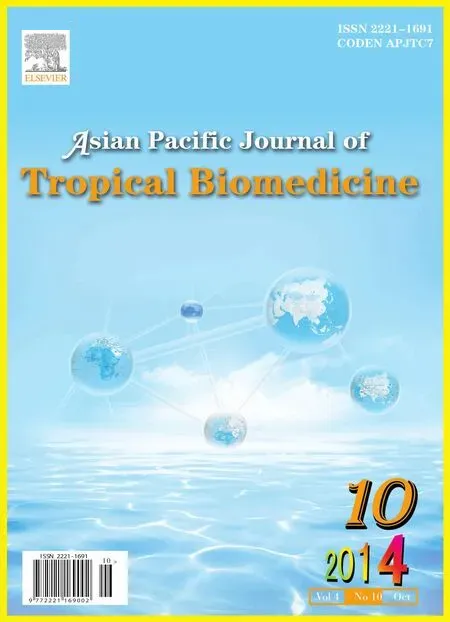Acute pancreatitis induced by Viburnum opulus juice in a patient with urolithiasis
2014-03-20ZuhalDagGalipAkturkLeventFilik
Zuhal Dag, Galip Akturk, Levent Filik
Ankara Research Hospital, Departments of Internal Medicine and Gastroenterology, Ankara, Turkey
Acute pancreatitis induced by Viburnum opulus juice in a patient with urolithiasis
Zuhal Dag*, Galip Akturk, Levent Filik
Ankara Research Hospital, Departments of Internal Medicine and Gastroenterology, Ankara, Turkey
Dear editor
Viburnum opulus(V. opulus) is a common plant throughout the world especially grown in Europe, Northern Africa and Asia[1]. It is used usually in homeopathy to reduce smooth muscle tightness to relieve general muscle cramping or women’s menstrual cramps[1,2]. It also is given for prevention and treatment of urolithiasis. However, there is no enough data related with adverse effects ofV. opulus. Herein, we present an acute pancreatitis case induced byV. opulus. A 38-yearold male patient admitted to our hospital emergency room due to severe abdominal pain. His past medical history was uneventful except a milimetric renal stone in his left kidney detected 1 year ago. His laboratory investigation was within normal range except high levels of amylase (1 294 IU/L) and lipase (1 250 IU/L). His abdominal sonography showed an edematous pancreas. He has no recent alcohol consumption and drug or toxin exposure. He declared that he drank 2 glasses ofV. opulusextract water daily for last 4 d. Oral intake was stopped and fluid therapy was given. His abdominal pain relieved and sonography showed a resolved pancreas edema in 3rd day and the existing kidney stone. Also, his lipase and amylase levels returned to normal. He was discharged at 4th day with the advices of urology admission. In conclusion, researchers and clinicians should consider pancreatitis induced byV. opulusin their practice. Herein, we also underline that side effects shoud not be underestimated while overemphasizing the benefit of botanical remedies in homeopathy.
Conflict of interest statement
We declare that we have no conflict of interest.
[1] Brickell C. RHS A-Z encyclopedia of garden plants. United Kingdom: Dorling Kindersley; 2008, p. 1136.
[2] Cesonienė L, Daubaras R, Viškelis P, Sarkinas A. Determination of the total phenolic and anthocyanin contents and antimicrobial activity of Viburnum opulus fruit juice. Plant Foods Hum Nutr 2012; 67(3): 256-261.
10.12980/APJTB.4.201414B308
*Corresponding author: Dr. Zuhal Dag, Research Assistant of Internal Medicine, Ankara Research Hospital, Department of Internal Medicine, Ulucanlar, Altındag, TR06600, Ankara, Turkey,
Tel: 009005056406927
E-mail: zuhaldag86@hotmail.com
Article history:
Received 15 Jul 2014
Received in revised form 20 Jul, 2nd revised form 26 Jul, 3rd revised form 3 Aug 2014
Accepted 15 Aug 2014
Available online 26 Aug 2014
杂志排行
Asian Pacific Journal of Tropical Biomedicine的其它文章
- Disseminated toxocariasis in an immunocompetent host
- Human ophthalmomyiasis externa caused by the sheep botfly Oestrus ovis: a case report from Karachi, Pakistan
- Calcinosis circumscripta in a captive African cheetah (Acinonyx jubatus)
- Production and purification of a bioactive substance against multi-drug resistant human pathogens from the marine-sponge-derived Salinispora sp.
- In vitro antibacterial activity of leaf extracts of Zehneria scabra and Ricinus communis against Escherichia coli and methicillin resistance Staphylococcus aureus
- In vitro antioxidant and anti-inflammatory activities of Korean blueberry (Vaccinium corymbosum L.) extracts
